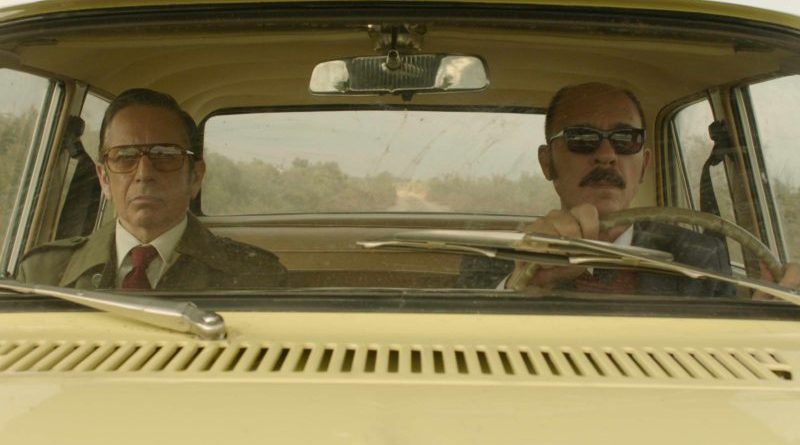INTERVIEW: New film ‘Rojo’ transports audiences to uncertain times in 1970s Argentina
Photo: From left, Alfredo Castro and Darío Gradinetti star in Rojo, the new film from director Benjamín Naishtat. Photo courtesy of Distrib Films US / Provided by press site with permission.
Rojo, the new film from director Benjamín Naishtat, follows the character of Claudio (Talk to Her’s Darío Grandinetti) as he spirals into a world of violence, secrets and historical significance. The 1970s-set movie, which will be released in New York City July 12, is meant to simultaneously capture a time period in the recent past and make strong parallels to the political winds of the 21st century.
“The first intentions of the project were to bring the story of the ’70s that would include also stories regarding militants and political repression,” Naishtat said in a recent phone interview. “But then over time I developed this idea of talking about the middle classes and their silent complicity with what was happening at the time, so it took a while to bring the story and the script together.”
The director was influenced by Argentina’s so-called Dirty War, when the country’s military dictatorship clashed with the population, and many people “disappeared.” It was a difficult time for Argentina, and Naishtat proceeds with care in resurfacing the themes of the day.
“Production wasn’t easy,” he said. “It never is. Particularly making a period drama is a challenge. It rises up costs obviously, so it took a while to put the money together.”
One of the welcome challenges of filming Rojo, which will play New York City’s Lincoln Center and Quad Cinema before opening July 19 in Los Angeles, was trying to capture a real sense of what the 1970s were like in Argentina.
“We put a lot of energy into that,” the director admitted. “We didn’t want to make a film where you would get the feeling of something being like retro or vintage. Instead of that, we worked with historians and sociologists that had access to archives, magazines from the time, TV programs from the time, in order to get everything right.”
Naishtat was particularly interested in bringing authenticity to the fashion on display in Rojo. He wanted the look of the film to be true to Argentina and not simply feature a nondescript 1970s vibe (bell bottoms, big hair, etc.), which is often the atmosphere of period films about the decade.
“So we put a lot of energy into that with the artistic crew,” Naishtat said. “We had an excellent art director. We had an excellent [director of photography], which he also got involved in researching the proper look, the proper lighting.”
The director had an exceptional cast to work with throughout the filming process. They were tasked with bringing to life the complicated and personal story of Claudio (Grandinetti), who is insulted one evening at a local restaurant by a stranger. After leaving the restaurant and walking home, Claudio and his wife, Susana (Andrea Frigerio), meet the stranger again, and what transpires is truly shocking. Starring with Grandinetti and Frigerio is celebrated Chilean actor Alfredo Castro.
Grandinetti “was certainly the most accurate choice,” the director said about the actor’s addition to the cast. “He gave the movie this sort of elegance that he carries in his way of walking, of moving. He’s a true film actor, which is something not so common in this industry. A lot of actors do a lot of stage theater, but Darío has pretty much done nothing else than films. He has worked a lot in the Spanish industry as well. He has worked with [Pedro] Almodóvar, and working with him was really easy. He’s a very technique actor, not the kind of actor that gets psychologically involved in the text. He’s a true cinema actor in the way that he creates the mechanics of his character, and he’s able to do 10 takes, one equal to the other, by correcting really metrical things that you point out to him. It made it really easy for me and for the rest of the group to work with a guy like him.”
Naishtat, who was born in 1986 in Buenos Aires, has made two other feature-length films: 2014’s History of Fear and 2015’s El Movimiento. This third feature has already brought the director a new honor: the Silver Shell award for Best Director at the San Sebastían Film Festival. Additionally, Rojo has played a host of top-notch festivals around the world, including Toronto, Rotterdam, Geneva and Hamburg.
Now, with Rojo set to premiere in the United States, the filmmaker hopes audience members walk away from a screening understanding the connective tissue between the 1970s and today.
“We are experiencing a rise in political forces that have a tendency to extreme right-wing ideas, fascist ideas, reactionary ideas where you see culture being threatened, diversity being threatened,” Naishtat said. “I think it’s a global thing going on, and the film does appeal to a time in the ’70s in which there was all across the region a surge of right-wing military governments and totalitarian orders. So I think we’re certainly in the risk of similar scenarios happening again in the region and around the world, and the film was made also to reflect and to invite the audience to think about how slowly we start naturalizing and accepting things that we shouldn’t.”
By John Soltes / Publisher / John@HollywoodSoapbox.com
Rojo, directed by Benjamín Naishtat, will be released Friday, July 12 in New York City at Lincoln Center and Quad Cinema. The film will be released Friday, July 19 in Los Angeles at the Laemmle Royal. Click here for more information.

